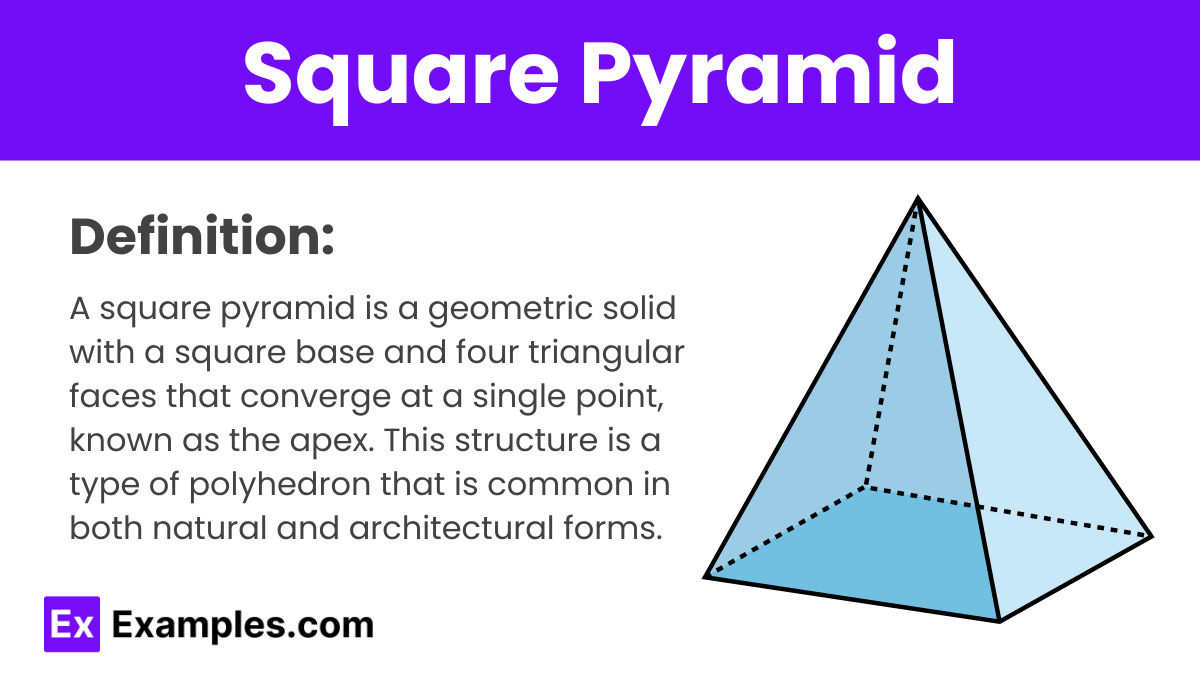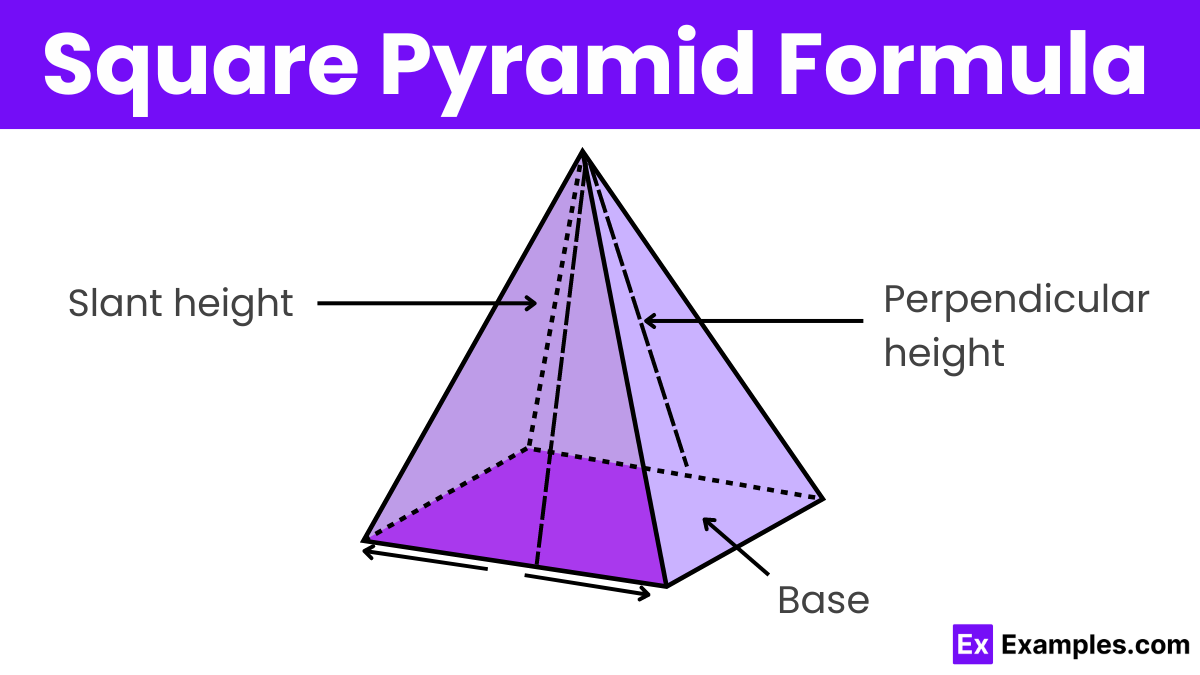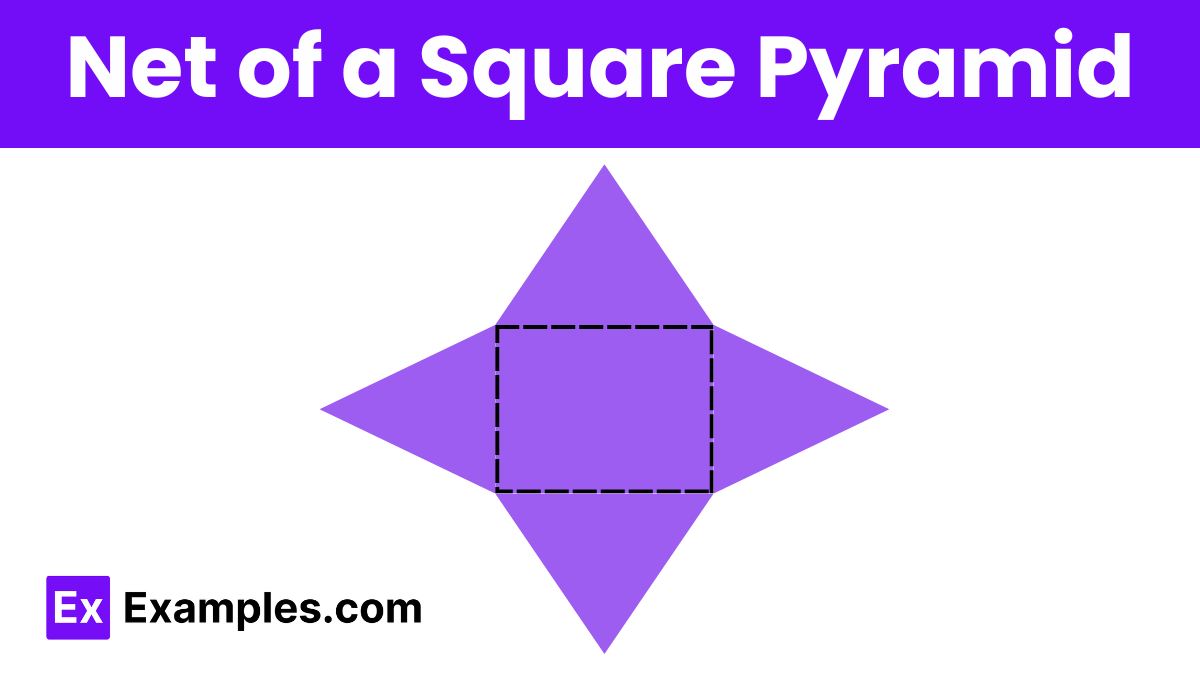What is the volume of a square pyramid with a base side length of 4 cm and a height of 9 cm?
48 cm³
56 cm³
60 cm³
64 cm³


A square pyramid is a three-dimensional geometric figure with a square base and four triangular faces converging at a point called the apex. In mathematics, this shape can be analyzed using algebra to explore its properties, such as volume and surface area. Concepts like square and square roots are vital in calculating these dimensions, especially when dealing with the pyramid’s height or slant height. Additionally, the least squares method, a statistical tool, may be used to optimize real-world pyramid constructions or models involving integers, rational, and irrational numbers. This integration of geometry with other mathematical disciplines like statistics and number theory highlights the interconnected nature of mathematical concepts. and the pyramids are Called after their base, such as

A square pyramid, characterized by a square base and triangular sides that meet at an apex, is a fundamental shape in geometry. Understanding how to calculate its volume and surface area involves specific formulas. Here are the key formulas used for a square pyramid:
The volume 𝑉 of a square pyramid is calculated by the formula:
Where:
Expressed with base side and height, the formula becomes: 𝑉 = 1/3𝑠²ℎ
The surface area 𝐴 of a square pyramid is the sum of the area of the base and the area of the triangular sides. The formula is:
Where:
The lateral surface area is the total area of just the triangular sides and is calculated without including the base:
This formula helps in finding the area of the material needed if the base is not covered.
Problem: Find the volume of a square pyramid with a base side length of 4 meters and a perpendicular height from the base to the apex of 9 meters.
Solution:
Using the formula for the volume of a square pyramid: 𝑉=1/3𝑠²ℎ.
Substitute the given values:
Answer: The volume of the pyramid is 48 cubic meters.
Problem: Calculate the surface area of a square pyramid with a base side length of 3 meters and a perpendicular height of 6 meters.
Solution:
First, calculate the slant height (𝑙) using the Pythagorean theorem (since the slant height is the hypotenuse of the triangle formed by the half of the base and the height):
Now, use the surface area formula:
The surface area of the pyramid is approximately 46.08 square meters.
Calculate the lateral surface area of a square pyramid with a base side length of 5 meters and a vertical height (from the base to the apex) of 12 meters.
Given:
First, we need to determine the slant height (𝑙), which is necessary for calculating the lateral surface area. The slant height can be found using the Pythagorean theorem in the right triangle formed by half the side of the base, the vertical height, and the slant height itself.
The formula for the lateral surface area is:
The lateral surface area of the square pyramid is approximately 122.6 square meters. This calculation shows how the geometry of the pyramid and basic trigonometry come together to solve practical problems involving real-world objects.
Square pyramids can be classified based on their symmetry, the orientation of their apex, and the relative lengths of their edges. Understanding these types helps in applications ranging from architectural design to geometric analysis. Here are the main types of square pyramids:

A net of a square pyramid is a two-dimensional representation that can be folded to form the three-dimensional shape of the pyramid. Understanding the net of a square pyramid helps visualize how the sides fit together and is particularly useful in educational contexts for teaching geometry, as well as in practical applications like crafting and architecture.
The net of a square pyramid consists of the following components:
Square pyramids, often studied in geometry and applied in various real-world contexts, have several key characteristics and properties that are crucial for understanding their structure and function. Here are some important notes on square pyramids:
Studying square pyramids helps students understand concepts of volume, surface area, and three-dimensional shape structure, enhancing spatial awareness and geometric visualization skills.
No, square pyramids are used in various fields besides mathematics, including architecture, engineering, and education. They serve as practical examples of geometric principles and are also aesthetically pleasing structures.
A regular square pyramid has its apex directly above the center of the base and is symmetrical, while an oblique square pyramid has an apex that is not aligned above the center of the base, causing the sides to be asymmetrical.

A square pyramid is a three-dimensional geometric figure with a square base and four triangular faces converging at a point called the apex. In mathematics, this shape can be analyzed using algebra to explore its properties, such as volume and surface area. Concepts like square and square roots are vital in calculating these dimensions, especially when dealing with the pyramid’s height or slant height. Additionally, the least squares method, a statistical tool, may be used to optimize real-world pyramid constructions or models involving integers, rational, and irrational numbers. This integration of geometry with other mathematical disciplines like statistics and number theory highlights the interconnected nature of mathematical concepts. and the pyramids are Called after their base, such as
Rectangular pyramid
Triangular pyramid
Square pyramid
Pentagonal pyramid
Hexagonal pyramid
A square pyramid is a geometric solid characterized by a square base and four triangular faces that meet at a single point, known as the apex or vertex. This structure is a common type of pyramid in which the base is a perfect square, and each of the base’s four sides is an identical isosceles triangle.
A square pyramid, characterized by a square base and triangular sides that meet at an apex, is a fundamental shape in geometry. Understanding how to calculate its volume and surface area involves specific formulas. Here are the key formulas used for a square pyramid:
The volume 𝑉 of a square pyramid is calculated by the formula:
V = 1/3×Base Area×Height
Where:
Base Area is the area of the square base and can be calculated as 𝑠² (where 𝑠s is the length of a side of the square).
Height (ℎ) is the perpendicular distance from the base to the apex.
Expressed with base side and height, the formula becomes: 𝑉 = 1/3𝑠²ℎ
The surface area 𝐴 of a square pyramid is the sum of the area of the base and the area of the triangular sides. The formula is:
A = s²+2s√(2s)²+h²
Where:
𝑠 is the length of a side of the square base.
ℎ is the slant height of the pyramid, not the vertical height. The slant height can be calculated using the Pythagorean theorem if not provided, using the relation Slant Height = √(𝑠/2)²+ℎ².
The lateral surface area is the total area of just the triangular sides and is calculated without including the base:
Lateral Surface Area = 2s√(s/2)²+h²
This formula helps in finding the area of the material needed if the base is not covered.
Base: The foundation of the square pyramid is a square, meaning all four sides are equal in length.
Faces: Aside from the square base, the pyramid has four triangular faces. Each triangle shares one side with the square base and the other two sides meet at the apex.
Vertex: The apex or vertex is the common point at the top where all triangular faces converge.
Edges: A square pyramid has eight edges—four edges of the base and four edges that are the sides of the triangles leading to the apex.
Symmetry: The pyramid has a vertical line of symmetry that passes through the apex and the center of the base.
Problem: Find the volume of a square pyramid with a base side length of 4 meters and a perpendicular height from the base to the apex of 9 meters.
Solution:
Base side length (𝑠): 4 m
Height (h): 9 m
Using the formula for the volume of a square pyramid: 𝑉=1/3𝑠²ℎ.
Substitute the given values:
𝑉=1/3×(4)²×9
𝑉=1/3×16×9
𝑉=1/3×144
𝑉=48 cubic meters.
Answer: The volume of the pyramid is 48 cubic meters.
Problem: Calculate the surface area of a square pyramid with a base side length of 3 meters and a perpendicular height of 6 meters.
Solution:
Base side length (𝑠): 3 m
Perpendicular height (ℎ): 6 m
First, calculate the slant height (𝑙) using the Pythagorean theorem (since the slant height is the hypotenuse of the triangle formed by the half of the base and the height):
𝑙 = √(𝑠/2)²+ℎ²
𝑙 = √(3/2)²+6²
𝑙 = √2.25+36
𝑙 = √38.25
𝑙 = 6.18 metersl≈6.18 meters
Now, use the surface area formula:
𝐴 = 𝑠²+2𝑠×𝑙
𝐴 = 3²+2×3×6.18
𝐴 = 9+37.08
𝐴 = 46.08 square meters.
The surface area of the pyramid is approximately 46.08 square meters.
Calculate the lateral surface area of a square pyramid with a base side length of 5 meters and a vertical height (from the base to the apex) of 12 meters.
Given:
Base side length (𝑠): 5 m
Vertical height (ℎ): 12 m
First, we need to determine the slant height (𝑙), which is necessary for calculating the lateral surface area. The slant height can be found using the Pythagorean theorem in the right triangle formed by half the side of the base, the vertical height, and the slant height itself.
𝑙 = √(𝑠/2)²+ℎ²
𝑙 = √(5/2)²2+12²
𝑙 = √2.5²+12²
𝑙 = √6.25+144
𝑙 = √150.25
𝑙 = 12.26 meters.
The formula for the lateral surface area is:
Lateral Surface Area = 2𝑠×𝑙
Lateral Surface Area = 2×5×12.26
Lateral Surface Area = 10×12.26
Lateral Surface Area = 122.6 square meters.
The lateral surface area of the square pyramid is approximately 122.6 square meters. This calculation shows how the geometry of the pyramid and basic trigonometry come together to solve practical problems involving real-world objects.
Square pyramids can be classified based on their symmetry, the orientation of their apex, and the relative lengths of their edges. Understanding these types helps in applications ranging from architectural design to geometric analysis. Here are the main types of square pyramids:
A regular square pyramid has a square base and four congruent triangular faces.
The apex (top vertex) is directly above the center of the base, making the line from the apex to the base’s center perpendicular to the base. This symmetry ensures that all the triangular faces are isosceles.
Often used interchangeably with a regular square pyramid, a right square pyramid is defined primarily by the perpendicular line from its apex to the center of the base.
It maintains symmetrical properties, with the apex aligned directly over the geometric center of the base.
Unlike the regular or right square pyramid, an oblique square pyramid has an apex that is not perpendicularly above the center of the base.
The triangular faces are not congruent in this pyramid, and the apex is offset, which results in two triangular faces being larger than the other two.
A truncated square pyramid, or a frustum of a pyramid, results when a square pyramid is sliced parallel to the base, cutting off the apex.
This type retains a square base, but the top is also a square, albeit smaller than the base. The sides are trapezoidal.
A net of a square pyramid is a two-dimensional representation that can be folded to form the three-dimensional shape of the pyramid. Understanding the net of a square pyramid helps visualize how the sides fit together and is particularly useful in educational contexts for teaching geometry, as well as in practical applications like crafting and architecture.
The net of a square pyramid consists of the following components:
This represents the base of the pyramid.
All four sides are of equal length.
These triangles represent the lateral faces of the pyramid.
Each triangle has a base that is equal in length to a side of the square and two sides that meet at the apex of the pyramid.
Square pyramids, often studied in geometry and applied in various real-world contexts, have several key characteristics and properties that are crucial for understanding their structure and function. Here are some important notes on square pyramids:
Volume: The volume of a square pyramid can be calculated using the formula 𝑉 = 1/3𝑠²ℎ, where 𝑠s is the length of a side of the base, and ℎ is the height from the base to the apex.
Surface Area: The total surface area includes the area of the base and the lateral surface area. It is calculated with 𝐴 = 𝑠²+2𝑠√(𝑠/2)²+ℎ², where ℎ is the slant height.
Symmetry: Regular square pyramids have a symmetrical structure about the vertical axis passing through the apex and the center of the base.
Architecture: Square pyramids are prominent in architectural designs, notably seen in ancient monuments like the Egyptian pyramids.
Engineering: Understanding the properties of square pyramids can help in designing roofs, supports, and other structural elements.
Geometric Understanding: Studying square pyramids aids in comprehending more complex geometric and three-dimensional shapes.
Problem Solving: Calculating areas and volumes of square pyramids integrates the use of algebra and trigonometry, enhancing problem-solving skills.
Nets: Creating a net for a square pyramid (a flat layout of the base and triangular sides) is a useful exercise in visualizing and understanding three-dimensional shapes.
Precision: Calculating the slant height and other derived measurements require precision, especially in a mathematical or engineering context, to ensure accuracy in computations.
Studying square pyramids helps students understand concepts of volume, surface area, and three-dimensional shape structure, enhancing spatial awareness and geometric visualization skills.
No, square pyramids are used in various fields besides mathematics, including architecture, engineering, and education. They serve as practical examples of geometric principles and are also aesthetically pleasing structures.
A regular square pyramid has its apex directly above the center of the base and is symmetrical, while an oblique square pyramid has an apex that is not aligned above the center of the base, causing the sides to be asymmetrical.
Text prompt
Add Tone
10 Examples of Public speaking
20 Examples of Gas lighting
What is the volume of a square pyramid with a base side length of 4 cm and a height of 9 cm?
48 cm³
56 cm³
60 cm³
64 cm³
Find the slant height of a square pyramid with a base side length of 6 cm and a perpendicular height of 8 cm.
7 cm
8 cm
9 cm
10 cm
What is the lateral surface area of a square pyramid with a base side length of 5 cm and a slant height of 7 cm?
60 cm²
70 cm²
80 cm²
90 cm²
Determine the total surface area of a square pyramid with a base side length of 6 cm and a slant height of 10 cm.
96 cm²
108 cm²
120 cm²
156 cm²
What is the height of a square pyramid with a base area of 25 cm² and a volume of 50 cm³?
5 cm
6 cm
7 cm
8 cm
Calculate the length of the diagonal of the base of a square pyramid with a side length of 7 cm.
7 cm
8 cm
9 cm
10 cm
What is the area of one triangular face of a square pyramid with a base side length of 8 cm and a slant height of 12 cm?
40 cm²
45 cm²
48 cm²
52 cm²
If the height of a square pyramid is 9 cm and the volume is 108 cm³, what is the length of the base side?
4 cm
5 cm
6 cm
7 cm
Find the height of a square pyramid with a base side length of 5 cm and a volume of 100 cm³
12 cm
14 cm
16 cm
18 cm
What is the perimeter of the base of a square pyramid with a base side length of 9 cm?
36 cm
38 cm
40 cm
42 cm
Before you leave, take our quick quiz to enhance your learning!

